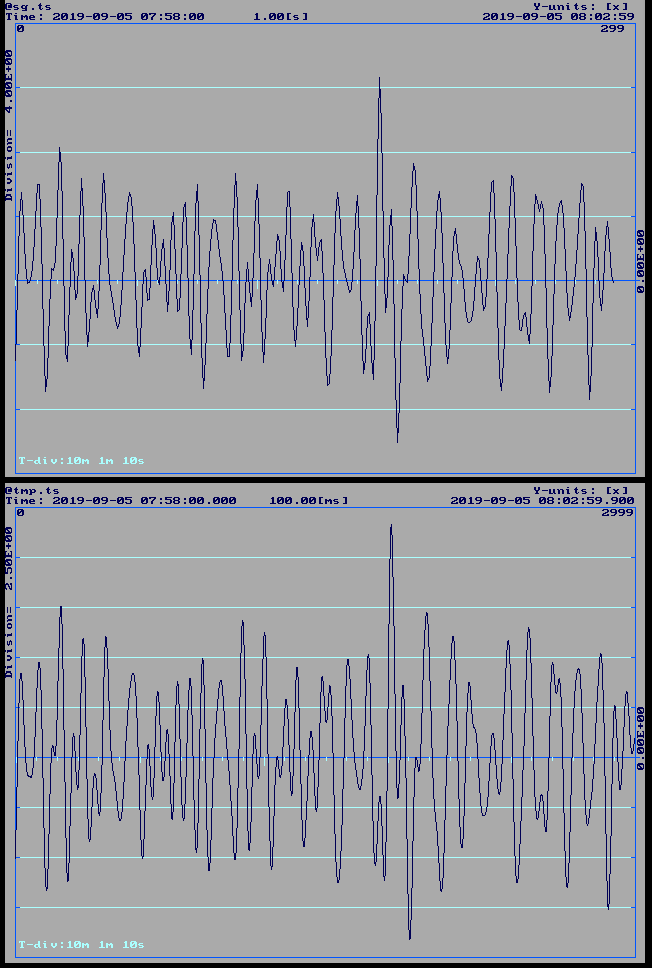#+
#
# USAGE: gcf2ts-like-SG-recently [-E]
# OPTION:
# -E - take seismograms from Elder (default is Utter)
#
#_
if ( x$1 == x-h ) then
helptext + _ $0
exit
endif
set scpe=scpu
if ( x$1 == x-E ) then
set scpe=scpe
endif
set ymd=`date -u "+%Y%m%d"`
set hour=`date -u "+%H"`
set rq = ( `jdc -C -Ah-1 -k1 -FT $ymd$hour` )
set rqd=$rq[1]$rq[2]${rq[3]}_$rq[4]'??'
$scpe -z "$rqd"
# get two hours from the Seismograph, from Elder or Utter
set rq = ( `jdc -C -Ah-2 -k1 -FT $ymd$hour` )
set rqb=$rq[1]$rq[2]${rq[3]}_$rq[4]'??'
$scpe -z "$rqb"
# Convert raw GCF (Guralp) to binary SAC:
set gcf = 3u93z2/${rqd}z.gcf
cat $gcf | gcfconv -v -l 6000 -f sac -d rcnt -S
set gcf = 3u93z2/${rqb}z.gcf
cat $gcf | gcfconv -v -l 6000 -f sac -d rcnt -S
# convert binary SAC to ASCII:
set sac = ( `ls -t rcnt/*/GCF.*.sac | head -2` )
sac2asc <$sac[1] >! rcnt/asc1
sac2asc <$sac[2] >! rcnt/asc2
# convert SAC to BIN-ts (HGS's proprietary binary format)
tslist rcnt/asc1 -A'>SAC]' -k4 -z0.0,1.0 -I -Y-1.78 -SO1.e-6 -o rcnt/tmp1.ts
tslist rcnt/asc2 -A'>SAC]' -k4 -z0.0,1.0 -I -Y-1.78 -SO1.e-6 -o rcnt/tmp2.ts
# append:
tslist-app -o tmp/tmp.ts -j+300000 -I + rcnt/tmp1.ts rcnt/tmp2.ts
# do the signal processing
# (see TSF EDIT 10SPS instruction block below)
tslist tmp/tmp.ts -I -E gcf2ts-like-SG-recently,10SPS -j+1800 -Un37800 -o rcnt/tmp.ts
# get the SG data from the "monitor"
# ( ~/www/SCG/monitor-36h.txt is not always actual at the end,
# so we concatenate the most actual ~/www/SCG/monitor.txt )
set begd = ( `tslq rcnt/tmp.ts | awk '/File begin/{print substr($0,25,20)}'` )
cat ~/www/SCG/monitor-36h.txt ~/www/SCG/monitor.txt |\
awk -v d="$begd" \
'($0 ~ d ){q=1} (q){print substr($0,15)}' |\
tslist - -gi4,5i3,t35,f10.0 -k3 -I -Un3600 -D -o rcnt/sg.ts |\
fgrep -v '>W>'
echo " "
echo "____________________________________________________________________"
echo " "
echo "The seismograph series reshaped to SG GGP:"
tslq rcnt/tmp.ts
echo "____________________________________________________________________"
echo " "
echo "The SG series:"
tslq rcnt/sg.ts
exit
TSF EDIT 10SPS
REMDC
FILTER D:WD KAIS 240 2.0 0.0 0.1 1.0 0.0 SAVE
PAD
ZSPF POWER:0 +BL +DISC +D -P -SPP
UNPAD
DECISYNC 100 10 0
;
; Doing acceleration
SCALE 1.0d-2
SCALE ${ONASCALEZ:[1.0]}
SETINDEX 0
LOOP 78 <132>
DO From # ###INDEX# For #6000
CPAD O=3000
; was 2400
ZSPF P&Z:5,2 /F [w]=rad/s UC=-1 SG=1.0 +DIFF +UG +BL -P -SPP
ZP(1) (-3.7e-2 , 3.7e-2)
ZP(2) (-3.7e-2 , -3.7e-2)
ZP(3) (-5.03e2 , 0.0 )
ZP(4) (-1.01e3 , 0.0 )
ZP(5) (-1.13e3 , 0.0 )
ZZ(1) ( 0.0 , 0.0 )
ZZ(2) ( 0.0 , 0.0 )
CUNPAD
DONE
ADDINDEX 6000
ENDLOOP <132> (N> ###INDEX#)
RSYNCUNPAD
REMDC
;
; doing GGP
PAD
ZSPF BESSEL:8 FC=${BSFFC:[0.0174533]} Hz -P -SPP
UNPAD
DONE
REMDC
SCALE ${SCALELIKEG:[27.504e6]}
END

The first 299 seconds into the time series, upper diagram: SG at 1 Sps,
lower diagram: Guralp Broadband Seismometer, GGP-filtered acceleration at 10 Sps.
Don't they look somewhat similar?